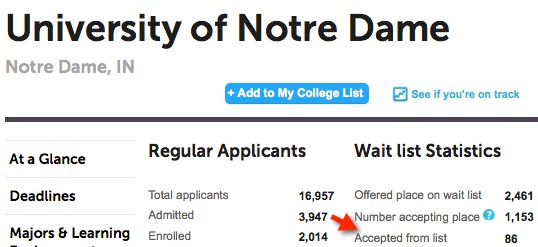
This is the season when colleges and universities are offering spurned applicants spots on their wait lists. I wanted to share this post that I wrote last year about wait lists. I have updated the wait list statistics for the University of Notre Dame. Lynn O’Shaughnessy
This weekend I heard from old friends who wanted to share with me stories of brilliant students who got shut out of elite universities.
At a party on Friday night, a former colleague of my husband’s mentioned that he was stunned that his son’s friend didn’t get into Stanford University. The boy is a stellar student and he only missed two or three answers on the SAT. He is a gifted jazz musician and throughout the party we were listening to an 
Yesterday a dear friend in Maryland told me about a young man she knew who was rejected by Johns Hopkins University and some Ivy League schools. This young man has been doing research at Johns Hopkins during his summer vacations and his extracurriculars were just as long and impressive as the kid from San Diego.
“Can you believe that this boy got rejected from all these schools?” my friend asked. I think I startled her when I said, “I’m not surprised. In fact, I would have been shocked if he got in.”
I am always amazed that brilliant children and their often accomplished parents have a disconnect when it comes to their admission expectations. When they look at Stanford’s admission rate of 6.6%, they don’t seem to think it applies to them. If anybody can explain this, I’d love to hear it.
The plight, if you can call it that, of these teenagers reminded me of the post that I wrote earlier this month:
What’s Wrong With College Dream Lists
Trying to Beat the Wait List Odds
I’m bringing this up today because many of these students who aimed too high are now hoping against hope that they will be plucked off the wait list of their dream college(s). I heard from one of these teenagers last week who wanted advice on how to get off the wait list of the University of Notre Dame.
I am equally surprised that students who unfortunately aimed too high think they can get lucky on the wait list. My advice to them is simple: Forget it. Move on and be happy with one of the schools that does want to see you in their freshman class.
Finding a School’s Wait List Statistics
To show you the futility of being on a wait list, let’s look at the odds. You can find the wait list odds of any school by heading to the College Board’s website. Type in the name of any school and when you are directed to its profile, click on its Applying hyperlink.
Here are Notre Dame’s wait list stats:
Wait List Overkill
As you can see, the number of applicants offered a spot on Notre Dame’s waiting list was more than the number of students in the eventual freshman class! Of the 2,461 students offered a place on the wait list, 1,153 accepted, but the school plucked just 86 from the list.
The previous year at Notre Dame 951 rejected students accepted a place on the wait list, but only seven were eventually offered spots.
This wait-list overkill is all too common. Many schools put an obscene number of students on the wait list.
Why do schools place so many kids on their waiting list when there is little to no chance of getting off of them? Because they can.
Their callous business decision isn’t going to discourage tons of students from applying the next year. Schools use their wait lists as a way to manage their admission yield. They also turn to the wait list as a way to reject students without completely demoralizing them.
What I find sad is that so many students are pinning their hopes on suitors that have spurned them. This prevents these teenagers from getting psyched for their grand adventure at whatever colleges they end up attending. And that’s a shame.




Thank you so much for the collegeboard.com waitlist statistics. I could not find them on college websites. why are colleges so secretive about their waitlist statistics? Also, I think people are shocked they don’t get into prestigious schools with low acceptance rates because they always thought they were the best in their class and are good enough to succeed at those schools.
Interesting to read info on wait lists… my son is in a different, but slightly related situation, because his favorite school offered him acceptance for a January start. He’s not happy about this because he wants to start in fall, and be part of the freshman community, etc. However, since the option to attend is still there, he’s not ready to move on to accepting another offer.
The college assures us there is similar orientation (albeit for a smaller group), and that the January start students are not at a disadvantage compared to other students. There are ample opportunities to “make up” the credits missing in fall by either attending a credited program in the fall, or taking summer courses.
We are going to attend the accepted students weekend, and my son is hoping to convince admissions to give him a spot in the fall.
Any advice for this situation would be appreciated!
Schools tend to offer January terms to students whose test scores and/or GPA aren’t as high. They want these students to attend in January because they don’t have to report these students’ statistics to U.S. News & World Report. I think it’s a disgusting practice. I’m not saying this is always why this happens, but it certainly is a reality at some schools.
Good luck!
Lynn O’Shaughnessy
Thanks for your reply. That is a pretty underhanded manipulation of statistics. I thought the January start was primarily a way to fill beds in the spring semester when more students are away on study abroad or have transferred.
Barbara,
I’m not saying this is why all schools have January terms, but it certainly is a motivation.
Lynn O.
This week the dreaded waitlist has become know in our household as the “friend zone.”
“We really like you and are so impressed by you, but we just can’t commit to a relationship. Can we just be friends?” This lack of outright rejection keeps you from moving on emotionally. There is still a possibility of some relationship in the future, but once in the “friend zone” you are not like to have a more serious relationship.
This week has been “friend zone” hell for my daughter who seems to have made herself attractive to lots of good schools, but only as a friend. First, it was Middlebury. “OK, there are other fish out there.” Next came Kenyon — “But I thought we were perfect for each other.” Then came Haverford – “Et tu Brute. ” Why can’t any of these schools make up their mind and say “yes” or “no?”
At last Whitman came through! Whew, finally a school willing to commit to a four year relationship! She is ecstatic since Whitman was one of her top three schools. Now she can decide what to do with any remaining suitors. She may just put them in her “friend zone.”
Thanks John for sharing. Whitman is a fantastic school. Congratulations to your daughter!
I’d forget about those other schools and get ready for a great freshman year.
Good luck to her.
Lynn O’Shaughnessy
I took my son on a tour of Stanford a year ago. Although I figured he’d have little chance of getting in, after the tour I knew there was no chance. I was told that for its most recent admissions cycle, the school had rejected more than 800 valedictorians. How’s that for sobering?
Lynn,
Great analysis of the wait list dilemma and the hopeful expectations of parents and students that aren’t based on the actual numbers. With single digit admissions rates as you point out, universities are regularly sending rejection letters to great students with top scores, high grades, and excellent activities.
These days a wait list offer can be similar to an honorable mention– it recognizes a student’s potential, but rarely results in admission.
Thanks Megan. I think students and parents are just as unrealistic about their wait list prospects as they were on their chances of getting in during the first round.
Lynn OShaughnessy
Thanks for the post but I disagree with your implication that waitlisted kids somehow miscalculated by aiming “too high.” It seems to me that if you don’t get rejected/waitlisted somewhere, it means that you have underestimated yourself.
Hi Joanne,
Sorry but I disagree with you on this one. Only 2% of four-year colleges and universities reject 75% or more of their clients. What’s more, the UCLA annual survey of freshmen show that around 74% of students get into their first choice school.
Lynn O’Shaughnessy
Lynn,
I agree that top students need to have more realistic expectations! I just wrote a post on this regarding my daughter’s experience with The University of Chicago: http://www.mykidscollegechoice.com/2013/03/16/the-pros-and-cons-of-being-waitlisted/
Luckily, she wasn’t putting all her hopes on getting in there. We decided up front to be overjoyed if she didn’t get in and not disappointed if she didn’t, so getting on the waitlist actually seemed like a decent accomplishment!